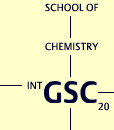 |


![]()
Name: Mohammed Saleem
Diploma / M.Sc degree: Jawarharlal Nehru University, New Delhi, India
(2005)
Title: Lipid specificity of SP-C variants and the SP-B model peptide KL4
Abstract of Research Project
Pulmonary surfactant is a mixture of surface active substances like phospholipids, proteins and carbohydrates
which is essential for normal breathing and alveolar stability. It is also assumed to avoid non-cardiogenic
edema going against the Laplace law and is implicated in the lung innate host defense system. Deficiency
in pulmonary surfactant leads to conditions such as neonatal and acute respiratory distress syndromes.
Lung surfactant has two very interesting biophysical properties that underlie its physiological functions:
1) Once secreted to the alveolar spaces, surfactant adsorbs rapidly to the interface. This happens during
a newborn baby's first breath and all along during the cycling of the surfactants.
2) Once at the interface, surfactant films reduce surface tension close to extremely low values when
compressed during expiration.
The two important hydrophobic surfactant proteins SP-B and SP-C independently accelerate film formation
by enhancing the adsorption and spreading of surfactant phospholipids at an air/liquid interface.
However, the manner in which SP-B and SP-C associate with the surface film, traditionally considered being
a monolayer and intact with the phospholipids is not clear.
Therefore, the aim of this study is to investigate the interaction between various SP-C variants and
the SP-B model peptide KL4 with lipid monolayer and ultimately to decipher the structure-function
relationship.
In order to gain an understanding of the molecular processes within the monolayer, first, static monolayer
studies of lipid systems containing different SP-C variants and SP-B model peptides will be performed.
The chemical distribution of the peptides and the lipids will be visualized on a solid support using
TOF-SIMS (time of flight-secondary ion mass spectrometry).The analysis is performed with Langmuir-Blodgett
films transferred from the air/water interface to the substrate and the localization of the peptides and
different lipids is also visualized in situ at the air/water interface using FRET (fluorescence resonance energy transfer).
The second approach deals with the dynamic studies and kinetic characterization of the surfactant protein
induced insertion of lipid vesicles into lipid monolayers containing surfactant protein analogues.
Various approaches such as SFM (scanning force microscopy), TOF-SIMS will be used to analyse the LB
films after vesicle insertion. In addition FRET measurements to study the interaction between vesicles and
the monolayers will be performed. With the result of this work we hope to improve the understanding of the
structure-function relationship of the surfactant proteins and the lipid specificity of SP-C variants and
SP-B model peptides. They also might strengthen the impact of artificial surfactant material as substituents
for native surfactant material in medical treatment.
Publications
U. Klenz, M. Saleem, M. C. Meyer, H. J. Galla
Influence of lipid saturation grade and head group charge: A refined lung surfactant adsorption model
Biophys. J. 95 (2008), 699-709.
M. Saleem, M. C. Meyer, D. Breitenstein, H. J. Galla
The surfactant peptide KL4 in lipid monolayers: phase behavior, topography, and chemical distribution
J. Biol. Chem. 283 (2008), 195-207.
Mohammed Saleem
eMail: Mohammed Saleem Shaikh